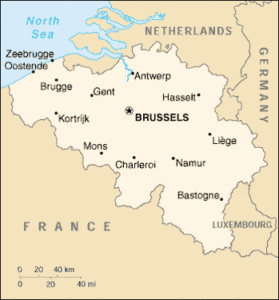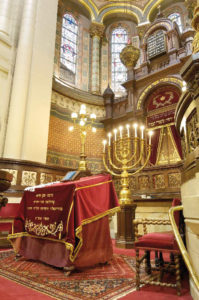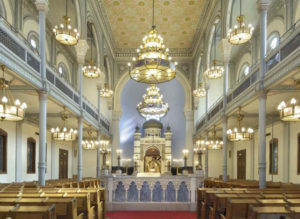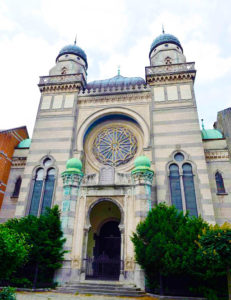 Jews followed the path of the Roman legions to Belgium in the years 53-57 CE. Written evidence, however, only dates back to the 13th century. Hebrew tombstones and street names like “rue des Juifs” have been traced to 1255. Other sources mention Jews as early as 1200 in the Brabant province. Anti-Jewish measures can also be traced back to the 13th century.
Jews followed the path of the Roman legions to Belgium in the years 53-57 CE. Written evidence, however, only dates back to the 13th century. Hebrew tombstones and street names like “rue des Juifs” have been traced to 1255. Other sources mention Jews as early as 1200 in the Brabant province. Anti-Jewish measures can also be traced back to the 13th century.
Jews returned to Belgium in the early 16th century after the Spanish and Portuguese expulsions of 1490s. Marranos settled in Antwerp at the end of the 15th and the beginning of the 16th century and played an important role in opening up the precious-stones industry, including diamonds and pearls, and developing the sugar trade as well as the first international stock exchange in Europe in 1536. Between 1650 and 1694, a secret synagogue conducted services in Antwerp.
When Austria began ruling Belgium in 1713, it allowed for a more open society, but Jews had to pay special taxes to limit their numbers. Under French (1794-1814) and later Dutch (1814-30) rule, the roughly 800 Jews in the country enjoyed greater freedoms. The principal communities in Belgium at the time were in Antwerp, Brussels, Herentals, Liège, and Mons.
In 1914, at the beginning of World War I, the Jews of Antwerp sought refuge over the border in the Netherlands, which remained neutral until the armistice in 1918. They congregated in Amsterdam, the Hague and Scheveningen. In 1939 a large part of Antwerp Jewish population fled to Cuba. Some returned years later; other went on to the United States.
 When Eastern European Jews began fleeing hostile areas and settling in Belgium, Antwerp’s Jewish community doubled from 8,000 people in 1880 to 16,000 in 1920. The first large synagogue in Antwerp, built in an oriental style, was inaugurated on Bouwmeestersstraat in 1893. This synagogue is still known as the Dutch synagogue. Another synagogue was built on Hoveniersatraat and was opened in 1913. A third Jewish community known as Machsike Hadas was organized in 1892 and their synagogue was opened in 1918 on Oostenstraat. The Great Synagogue was built in 1928.
When Eastern European Jews began fleeing hostile areas and settling in Belgium, Antwerp’s Jewish community doubled from 8,000 people in 1880 to 16,000 in 1920. The first large synagogue in Antwerp, built in an oriental style, was inaugurated on Bouwmeestersstraat in 1893. This synagogue is still known as the Dutch synagogue. Another synagogue was built on Hoveniersatraat and was opened in 1913. A third Jewish community known as Machsike Hadas was organized in 1892 and their synagogue was opened in 1918 on Oostenstraat. The Great Synagogue was built in 1928.
At the outset of World War II, more than 100,000 Jews were in Belgium, including 55,000 in Antwerp and 35,000 in Brussels, with smaller communities in Ghent, Liege, Arlon, Mons, Charleroi, Namur and Oostende. There were at least 20,000 were not Belgian citizens, and many were recently arrived refugees from Germany, Austria and Poland.
On May 10, 1940, Nazi Germany invaded Belgium, taking just 18 days to put the country under military rule which lasted until liberation in September 1944. Anti-Jewish measures began in the autumn of 1940 and grew worse over time. The first prohibitions included ritual slaughter and other religious rites. Other discriminatory actions followed with the Nazis prohibiting Jews from certain professions, such as the fields of law and education. By 1941, authorities started to confiscate property, including the diamond exchange, to set up curfews and to confine Jews to cities. The Nazis ordered Jews to wear yellow badges in early 1942 and, in September of that same year, began rounding them up by the thousands and deporting them, mostly to Auschwitz. Very few Belgian Jews survived concentration camps.
 An active resistance movement supported by both Jews and non-Jews prevented a higher death toll. The exiled Belgian government, as well as the Catholic Church and the Belgian populace, still upset by the German occupation in World War I, resisted a second German occupation. A higher proportion of Jews were saved in Belgium than most other occupied countries. Initially, when the Germans had trouble identifying Jews because the Belgian constitution does not permit mention of religion on civil documents, most Belgians never assisted. In fact, many helped Jews. Christian families hid Jewish children and usually honoured their requests against baptism. And after the war, almost all Jewish children were returned to their families. In 1942, the Nazis had difficulty finding Belgian police officers to help them put yellow badges on Jews. With the help of the Jewish resistance, about 800 Jews were able to hide in the city of Antwerp.
An active resistance movement supported by both Jews and non-Jews prevented a higher death toll. The exiled Belgian government, as well as the Catholic Church and the Belgian populace, still upset by the German occupation in World War I, resisted a second German occupation. A higher proportion of Jews were saved in Belgium than most other occupied countries. Initially, when the Germans had trouble identifying Jews because the Belgian constitution does not permit mention of religion on civil documents, most Belgians never assisted. In fact, many helped Jews. Christian families hid Jewish children and usually honoured their requests against baptism. And after the war, almost all Jewish children were returned to their families. In 1942, the Nazis had difficulty finding Belgian police officers to help them put yellow badges on Jews. With the help of the Jewish resistance, about 800 Jews were able to hide in the city of Antwerp.
The Committee for Jewish Defense (CJD), affiliated with the national Belgian resistance movement, worked on several levels. The organization hid Jews, fought as partisans, forged identity papers and food ration tickets, obtained funds and set up escape routes. However, between 1942-44, more than 25,000 Belgian Jews perished in the Holocaust. Many of the Jews in hiding joined the armed resistance. In April 1943, members of the CDJ attacked the twentieth rail convoy to Auschwitz and succeeded in rescuing around 217 of those being deported.
 Queen Elizabeth of Belgian played a significant role in saving Belgian Jews. In August 1942, through the agency of the Italian royal family and the Red Cross, she made a direct demand to Hitler to cease the removal of Jews from Belgium. In reply, she received a promise that Jews with Belgian citizenship would neither be deported nor would they be separated from their families. The Germans did not keep their promise and deported them a few months later. Other royals who helped the Jews included Princess Elena of Greece and Denmark and Princess Alice.
Queen Elizabeth of Belgian played a significant role in saving Belgian Jews. In August 1942, through the agency of the Italian royal family and the Red Cross, she made a direct demand to Hitler to cease the removal of Jews from Belgium. In reply, she received a promise that Jews with Belgian citizenship would neither be deported nor would they be separated from their families. The Germans did not keep their promise and deported them a few months later. Other royals who helped the Jews included Princess Elena of Greece and Denmark and Princess Alice.
 In the decades after World War II, thousands of Jewish refugees from Eastern and Central Europe made their way through Belgium, most awaiting immigration permits to other countries of permanent settlement. Belgium slowly rebuilt its infrastructure, the Jewish community included. Today, the total Jewish population in Belgium is approximately 30,000, with a high concentration in Brussels and Antwerp. Small Jewish communities exist in Charleroi, Oostende, Ghent, Liege, Mons, Arlon, Waterloo and Knokke.
In the decades after World War II, thousands of Jewish refugees from Eastern and Central Europe made their way through Belgium, most awaiting immigration permits to other countries of permanent settlement. Belgium slowly rebuilt its infrastructure, the Jewish community included. Today, the total Jewish population in Belgium is approximately 30,000, with a high concentration in Brussels and Antwerp. Small Jewish communities exist in Charleroi, Oostende, Ghent, Liege, Mons, Arlon, Waterloo and Knokke.
In 2002, as anti-Semitism flared throughout Europe and immigrants were rioting in Antwerp, some violence was directed at Jews in Belgium. In late November, a Molotov cocktail was thrown at a synagogue in Antwerp. During 2014, multiple anti-Semitic attacks were carried out against the Jewish community. On Saturday May 24, a suspect later identified as Mehdi Nemmouche opened fire at the Jewish Museum in Brussels in an attack identified by authorities as a clear act of anti-Semitism and terrorism. Two Israelis were injured in the March 22, 2016, terror attack on an airport and train station in Brussels. Multiple suicide bomb blasts rocked the Belgium national airport and the Maelbeek train station, killing 31 and injuring more than 250.
 In 2015, 287 Belgian Jews made Aliyah to Israel, the greatest number of Belgian immigrants recorded in a decade. From 2010-2015, an average of 234 Belgian Jews made Aliyah annually, and from 2005-2009, 133 Belgian Jews on average made Aliyah annually. The Belgian Jewish community currently numbers around 30,000, most of whom live in Brussels or Antwerp, the country’s two largest cities. Belgium has 30 synagogues, in Antwerp and more than 10 synagogues in Brussels. The country’s main synagogue, ‘La Régence’, was re-dedicated in 2008 as the Great Synagogue of Europe. There are seven Jewish schools in Antwerp and three in Brussels, from kindergarten to secondary schools. The great majority of Jewish children in Antwerp are educated in the Jewish school system and receive an intensive religious education.
In 2015, 287 Belgian Jews made Aliyah to Israel, the greatest number of Belgian immigrants recorded in a decade. From 2010-2015, an average of 234 Belgian Jews made Aliyah annually, and from 2005-2009, 133 Belgian Jews on average made Aliyah annually. The Belgian Jewish community currently numbers around 30,000, most of whom live in Brussels or Antwerp, the country’s two largest cities. Belgium has 30 synagogues, in Antwerp and more than 10 synagogues in Brussels. The country’s main synagogue, ‘La Régence’, was re-dedicated in 2008 as the Great Synagogue of Europe. There are seven Jewish schools in Antwerp and three in Brussels, from kindergarten to secondary schools. The great majority of Jewish children in Antwerp are educated in the Jewish school system and receive an intensive religious education.